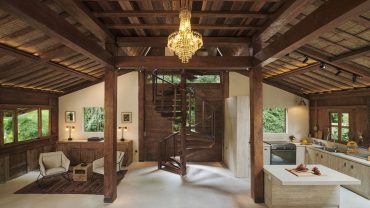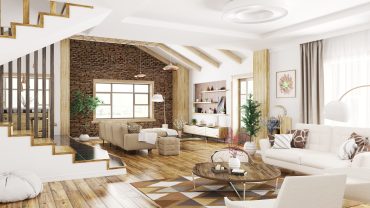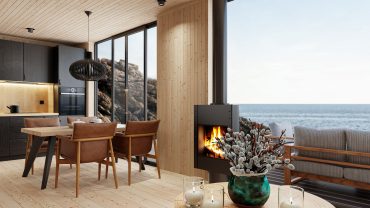Artisan interior design represents a harmonious blend of craftsmanship, individuality, and cultural heritage within living spaces.
Rooted in the appreciation of handcrafted items and bespoke elements, this design approach emphasises uniqueness and personal expression over mass-produced uniformity. By incorporating artisanal pieces, artisan home interiors become reflections of artistry and tradition, offering depth and character to homes.
The Essence of Artisan Interior Design

Handmade plank dining table (Credit: alvarez via Getty Images)
At its core, artisan interior design celebrates the skill and creativity of craftspeople and artisans. It involves integrating handcrafted furnishings, textiles, and decor that showcase meticulous attention to detail and a high level of craftsmanship. This artisan interior design style moves away from generic, factory-made items, favouring pieces that tell a story and carry the mark of the maker’s hand.
Emphasis on Handcrafted Elements

Handcrafted furniture is the essence of artisan interior design (Credit: Alistair Berg via Getty Images)
Handmade items are central to artisan interior design. These pieces often feature imperfections and unique characteristics that mass-produced goods lack. The use of materials such as reclaimed wood, hand-forged metals, and natural fibres contributes to an authentic and organic aesthetic. Furniture might include hand-carved details, while textiles could feature handwoven patterns or traditional dyeing techniques, embodying the essence of artisan style decor.
Cultural and Historical Influences

Artisan design takes influences from all periods, such as Tudor Revival (Credit: Andreas von Einsiedel via Getty Images)
Artisan style interior design often draws inspiration from various cultures and historical periods. By incorporating elements from different traditions, interiors gain a rich tapestry of influences. Such inclusions not only enhance visual interest but also bring a fascinating and often eclectic mix to the interior space.
Materials and Techniques

Forged metal is a feature of artisan decor (Credit: boonsom via Getty Images)
The materials and techniques used in artisan interior design are as important as the finished products themselves. The focus is on natural, sustainable materials and time-honoured crafting methods.
Sustainable & Natural Materials
Sustainability is a key consideration in selecting materials. Natural woods, stone, clay, and fibres like cotton, wool, and linen are popular choices. These materials not only offer durability but also add warmth and texture to spaces. The use of reclaimed or recycled materials is common, aligning with eco-friendly principles and adding a sense of history to artisan home interiors.
Traditional Crafting Techniques
Artisan interior design values traditional crafting techniques passed down through generations. Methods such as woodworking, metal forging, pottery, weaving, and embroidery are prominently featured. These techniques contribute to the authenticity of the pieces and preserve important crafts and practices, enhancing the focus on artisan style decor.
Integration into Modern Spaces

Old and new working in harmony (Credit: John Keeble via Getty Images)
While rooted in tradition, artisan interior design can seamlessly blend with contemporary aesthetics. The key is balancing handcrafted elements with modern design principles.
Blending Old & New
Combining artisanal pieces with modern furnishings creates a dynamic and layered look. A sleek, minimalist room can be warmed with a handcrafted wooden table or a handwoven rug. This contrast highlights the unique qualities of artisanal items against a modern backdrop, embodying the essence of artisan interior design style.
Personalisation & Storytelling
Artisan design allows for personalisation, making spaces truly unique. Each piece often has a story, whether it is the artisan’s inspiration or the personal or cultural significance behind the crafting technique. Displaying these items turns interiors into narratives, reflecting the owners’ tastes, experiences, and values within their artisan home interiors.
Ethos of Artisan Home Interiors
Proponents of artisan interior design often view it as offering several benefits beyond simple aesthetic appeal, such as supporting artisans and communities by buying directly. It’s also usually seen as promoting sustainability and fostering a deeper connection to the environment.
Challenges and Considerations

Antique shops and flea markets are artisan design goldmines (Credit: Ekely via Getty Images)
While artisan interior design offers numerous advantages, there are challenges to consider. These include accessibility, cost, and ensuring authenticity.
Accessibility & Availability
Artisanal items may not be as readily available as mass-produced goods. Sourcing these pieces can require additional effort, such as visiting specialised stores, markets, or commissioning custom work.
Cost Implications
Handcrafted items often come at a higher price point due to the time and skill involved in their creation. Budget considerations are important, and it may require prioritising certain pieces or gradually incorporating artisanal elements over time into the artisan home interiors.
Authenticity & Ethical Sourcing
Ensuring that items are authentically crafted and ethically sourced is crucial. With the rise in popularity of artisanal goods, there’s a risk of counterfeit or mass-produced items marketed as handmade. Verifying the origins and the artisans behind the products helps maintain the integrity of the artisan style decor.
Summarising the Artisan Interior Design Style

An artisan craftsman at work (Credit: ugurhan via Getty Images)
By emphasising handcrafted elements, cultural influences, and sustainable practices, artisan interior design transforms interiors into personalised and meaningful environments. While there are challenges in accessibility and cost, the benefits and unique approach make it a compelling choice for those seeking authenticity and individuality in their homes through artisan style interior design.












